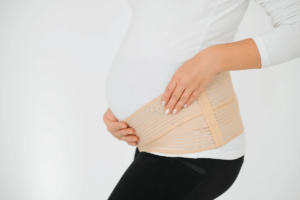Pregnancy is a remarkable journey, bringing joy, anticipation, and significant physical changes. As the body adjusts to accommodate a growing baby, many expecting mothers experience discomfort, particularly in the lower back, pelvis, and abdominal region. This is where a maternity belly band becomes an essential tool for comfort and support. In this comprehensive guide, we’ll explore everything you need to know about belly bands, including their benefits, types, selection tips, and safety considerations.

What Is a Maternity Belly Band?
A maternity belly band is a supportive elastic garment worn around the abdomen. Its primary function is to provide gentle compression and support to the growing belly, helping distribute weight more evenly across the lower back and pelvis. Unlike traditional maternity belts, belly bands are designed to be soft, flexible, and comfortable enough for daily wear, often hidden discreetly under clothing.
Benefits of Wearing a Belly Band During Pregnancy
Using a maternity belly band offers multiple advantages that can significantly improve comfort during pregnancy:
1. Back Pain Relief
Back pain is one of the most common complaints among pregnant women. As the belly grows, the center of gravity shifts forward, placing extra stress on the lower back. A belly band provides gentle support to the abdomen, helping redistribute weight and reduce muscle strain.
2. Pelvic Support
Pregnancy hormones, such as relaxin, loosen ligaments and joints in the pelvis, which can lead to pelvic discomfort or instability. A belly band supports the pelvis, reducing pressure and alleviating pain, particularly during walking, standing, or light physical activity.
3. Abdominal Support
As the baby grows, the abdominal muscles stretch and weaken, potentially causing discomfort and poor posture. Belly bands help support these muscles, reducing strain on the abdomen and providing a feeling of stability.
4. Improved Posture
By supporting the belly, belly bands encourage better posture, which can help prevent the slouching that often occurs as a pregnancy progresses. Proper posture also reduces the risk of musculoskeletal discomfort and fatigue.
5. Reduced Swelling and Pressure
Some belly bands offer compression features that help reduce swelling in the lower abdomen and legs. By supporting the lower belly, the band may ease pressure on the bladder and improve overall comfort, particularly in the later stages of pregnancy.
Types of Maternity Belly Bands
Not all belly bands are created equal. Choosing the right type depends on your specific needs, comfort preferences, and intended use. Here’s a breakdown of the most common types:
| Type | Description |
| Basic Belly Bands | Soft, elastic bands that provide gentle support for everyday wear. |
| Support Belts | Structured bands with adjustable straps for enhanced back and pelvic support. |
| Postpartum Bands | Designed to support abdominal muscles after childbirth and aid recovery. |
| 2-in-1 Bands | Can be used during pregnancy and postpartum for continuous support. |
| Adjustable Panel Bands | Feature extra panels that can be loosened or tightened as the belly grows. |
Each type offers a different level of support and comfort, so it’s essential to assess your needs before making a purchase.
How to Choose the Right Belly Band
Selecting the right maternity belly band requires considering several key factors:
Size
Proper sizing ensures comfort and effectiveness. Measure your waist and hip circumference at the widest point and refer to the manufacturer’s sizing chart. A band that is too tight may restrict blood flow or breathing, while one that is too loose won’t provide adequate support.
Material
Opt for breathable, stretchable fabrics like cotton, spandex, or bamboo blends. These materials reduce irritation, wick away moisture, and adapt to your body’s changing shape. Some high-end brands also include antimicrobial or hypoallergenic fabrics to minimize skin irritation.
Adjustability
Pregnancy is a time of rapid physical change, so choose a band with adjustable straps or Velcro closures. Adjustable bands allow you to customize the fit and increase comfort as your belly grows.
Support Level
Consider your activity level and physical needs. If you have severe back pain or pelvic discomfort, a structured support belt may be more beneficial than a basic elastic band. Conversely, for light support, a simple stretch band may suffice.
Discreetness
If you plan to wear the belly band under clothing, choose seamless designs or low-profile bands that are virtually invisible under outfits. This allows you to maintain style and comfort simultaneously.
Safety Tips for Wearing a Belly Band
While belly bands are generally safe, using them correctly is crucial:
- Avoid Over-tightening: Excessive tightness may restrict blood flow, cause discomfort, and affect digestion. The band should feel snug but not constrictive.
- Limit Wearing Time: Avoid wearing the band continuously for long periods. Take breaks to allow your muscles to work naturally and avoid dependency.
- Consult Your Healthcare Provider: If you have conditions such as high blood pressure, varicose veins, or a history of preterm labor, consult your doctor before using a belly band.
- Monitor for Discomfort: Stop using the band immediately if you experience numbness, tingling, or increased pain.
When to Start Wearing a Belly Band
Most expecting mothers benefit from starting to wear a belly band in the second trimester, typically around 16–20 weeks. During this stage, the growing belly begins to place noticeable stress on the back and pelvis. However, some women with early discomfort may choose to start wearing a band earlier. Always check with your healthcare provider to determine the optimal timing for your situation.
Top Maternity Belly Bands to Consider
Based on expert recommendations and user reviews, here are some of the top maternity belly bands:
- Momcozy Ergonest Maternity Belly Band
Features advanced 3D molding and ergonomic design, targeting the abdomen and lower back. It alleviates strain and provides comfortable support during daily activities. - AZMED Maternity Belly Band
Offers targeted relief for round ligament pain and general abdominal discomfort. The adjustable design accommodates growth throughout pregnancy. - KeaBabies Pregnancy Belly Band
Provides support for both the abdomen and lower back, helping prevent or reduce lower back pain during pregnancy. - BellyBandit Upsie Belly
Offers gentle lifting and strong support, ideal for active moms-to-be who need extra comfort while maintaining mobility. - Blanqi Everyday Maternity Belly Support
Features compression panels that provide gentle but effective support, suitable for long hours of wear or workplace use.
Additional Considerations
Clothing Compatibility
When choosing a belly band, consider how it fits under your clothes. Bands that are too thick may be visible under fitted outfits, while thin, elastic bands often remain discreet.
Exercise and Activity
Some belly bands are specifically designed for prenatal exercise, providing additional support during walking, yoga, or light strength training. If you plan to stay active during pregnancy, look for breathable, high-stretch bands suitable for workouts.
Postpartum Use
Many maternity belly bands double as postpartum support belts, helping with abdominal recovery and posture correction after childbirth. These bands can be particularly helpful for new mothers who want extra support while resuming daily activities.
Travel and Mobility
For expecting mothers who travel frequently, lightweight and easily adjustable belly bands are ideal. They are portable and comfortable for long periods of sitting, such as during flights or car rides.
Long-term Benefits
Belly bands not only provide immediate comfort but may also offer long-term benefits:
- Reduced Risk of Back Injuries: By supporting the spine and abdomen, belly bands can reduce the likelihood of strains and injuries during pregnancy.
- Improved Circulation: Gentle compression can aid in blood flow, reducing swelling in the legs and feet.
- Enhanced Confidence: Feeling physically supported can improve confidence, making everyday activities more manageable and enjoyable.
FAQ
What is a maternity belly band?
A maternity belly band is an elastic garment worn around the abdomen to support the growing belly during pregnancy.
When should I start wearing a belly band?
It’s recommended to start wearing a belly band in the second trimester, especially if experiencing back or pelvic pain.
Are belly bands safe during pregnancy?
Yes, when used correctly, belly bands are safe and can help alleviate discomfort associated with pregnancy.
How do I choose the right size belly band?
Measure your waist circumference at the widest point and refer to the manufacturer’s sizing chart to select the appropriate size.
Can I wear a belly band postpartum?
Some belly bands are designed for postpartum use to provide support during recovery; ensure the product specifies this feature.

Conclusion
Choosing the right maternity belly band can significantly improve comfort, mobility, and overall well-being during pregnancy. From providing essential back and pelvic support to promoting better posture and easing abdominal strain, a high-quality belly band is an invaluable addition to any expecting mother’s wardrobe. When selecting a band, consider factors such as size, material, adjustability, support level, and whether it can be used postpartum. Always consult your healthcare provider if you have any medical concerns or conditions.



